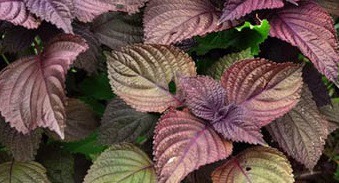 Fresh leaves of Perilla frutescens (perilla) are used as a culinary herb in East Asian countries such as Japan, Korea, and China. Perilla is an annual short-day plant that belongs to the Lamiaceae family along with many aromatic edible plants such as mint, basil, rosemary, sage, oregano, and thyme. In Asian countries, the dried leaves of perilla are used as raw material for crude drugs because they contain potent bioactive substances. A regular intake of plant-derived bioactive agents has gained popularity because of the health benefits. Fresh leafy greens, however, normally have a low concentration of such bioactive agents.
Fresh leaves of Perilla frutescens (perilla) are used as a culinary herb in East Asian countries such as Japan, Korea, and China. Perilla is an annual short-day plant that belongs to the Lamiaceae family along with many aromatic edible plants such as mint, basil, rosemary, sage, oregano, and thyme. In Asian countries, the dried leaves of perilla are used as raw material for crude drugs because they contain potent bioactive substances. A regular intake of plant-derived bioactive agents has gained popularity because of the health benefits. Fresh leafy greens, however, normally have a low concentration of such bioactive agents.
Scientists at Chiba University (Japan)have investigated how a simple drying process may influence the secondary metabolites in perilla leaves. This information should be valuable for researchers working in the development of plant-based foods and drugs. In the study, the drying was accomplished by spreading the leaves in darkness under atmospheric pressure at ambient temperature that ranged from 18 to 23°C for a period of three weeks.
"We found that drying markedly affected the accumulation of secondary metabolites and that dried leaves of perilla contained more anticancer flavonoids than fresh leaves. Drying is a major method of food preparation, particularly for plant-based foods, but the quality of the bioactive agents contained in the fresh and dried leaves of perilla has received only scant attention. Quantitative analysis of the concentrations of nutraceuticals revealed that the effect of drying significantly increased apigenin (28-fold) and luteolin (86-fold), but decreased rosmarinic acid in all leaf stages. As regards the positive effect on flavonoid levels on perilla leaves, the comparison with fresh perilla leaves confirmed that the dried leaves contained greater concentrations of anticancer flavonoids regardless of variety, form, or manner of cultivation. This indicates that drying can significantly increase the level of flavonoids in perilla leaves without a loss of flavor. Therefore, drying is a simple and effective method to improve the concentrations of bioactive agents, which increases the intake of beneficial substances derived from herbs and edible plants. The study showed that the drying can be used as a method for food processing. It can provide raw materials rich in anticancer flavones that are suitable for use as nutraceuticals containing P. frutescens".
Source: Natsuko Kagawa, Hiroya Iguchi, Masahumi Henzan, Mitsumasa Hanaoka, 'Drying the leaves of Perilla frutescens increases their content of anticancer nutraceuticals', 2019, Food Science and Nutrition, Vol. 7, pag. 1494-1501.
